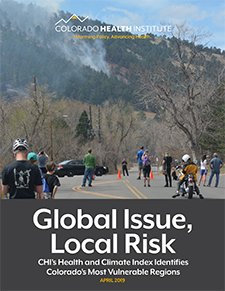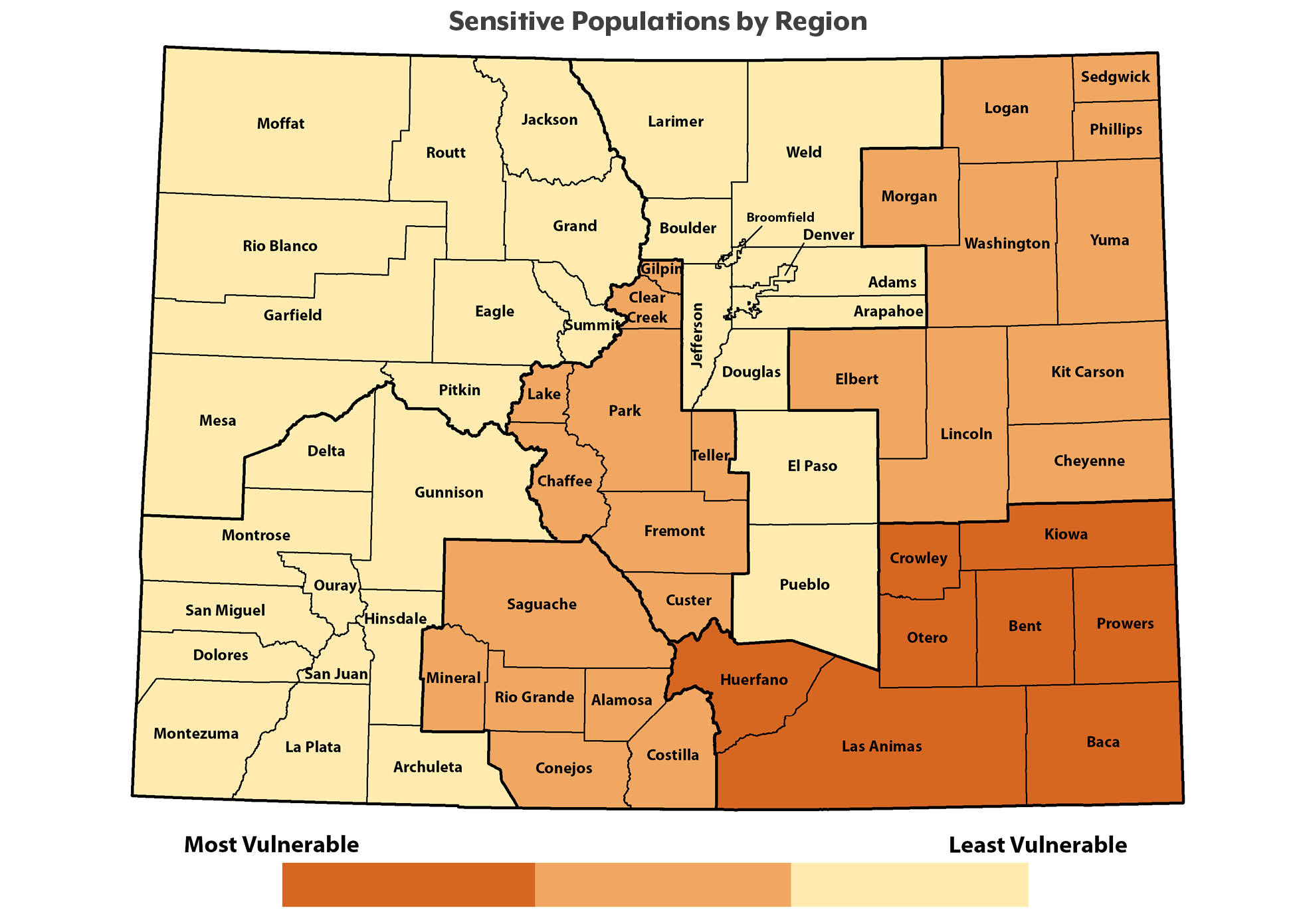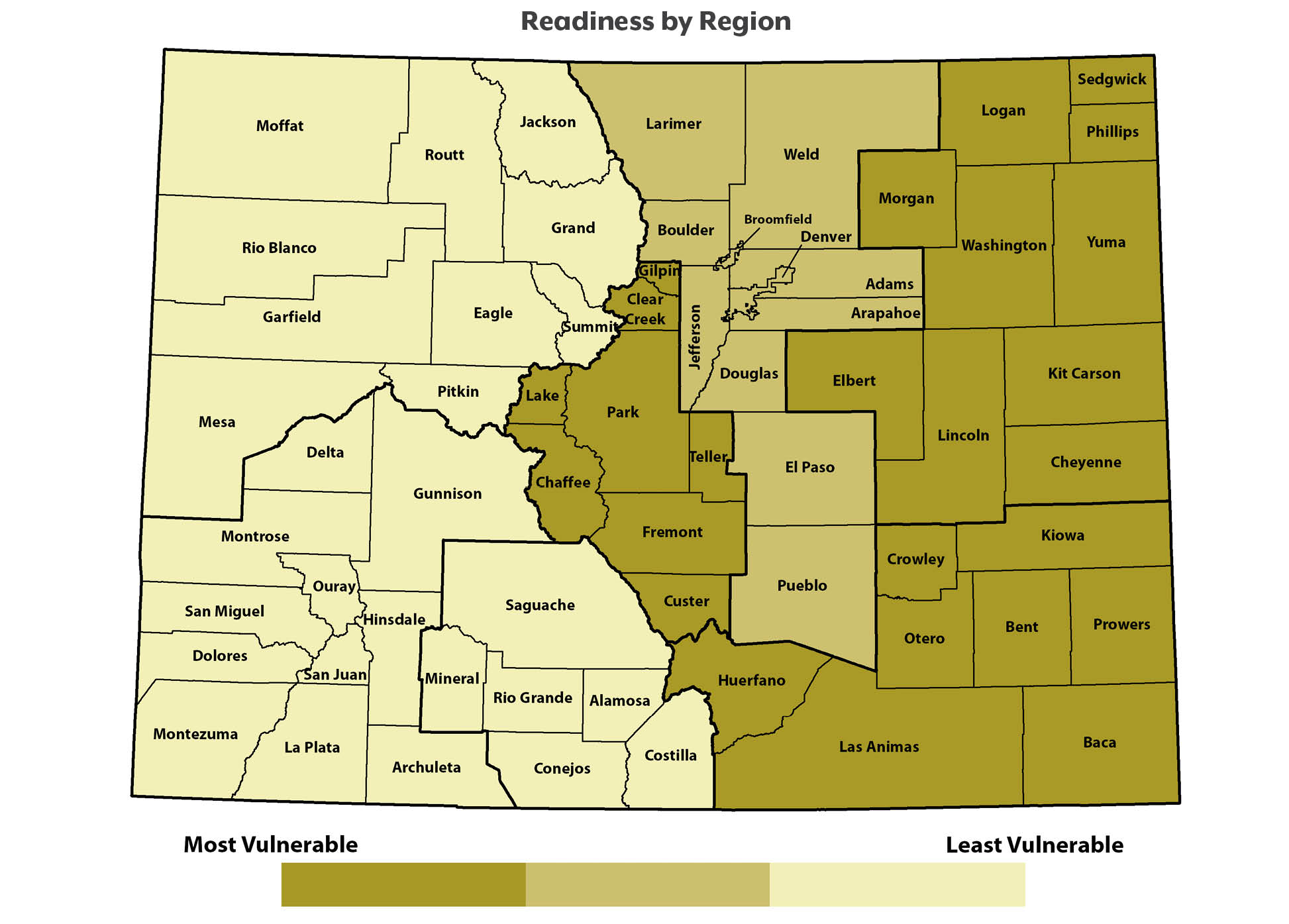
Global Issue, Local Risk
Key Takeaways
People in Colorado’s Eastern Plains are most at risk from potential harmful effects of climate change on human health.
Opinions questioning the reality of climate change are most prevalent in Colorado regions where people are more likely to suffer climate-related health effects.
Policymakers and the public can use CHI’s new Health and Climate Index to craft local responses to this global issue.
These changes directly affect the health of people across the state, increasing the risk of injury, illness and disease, or death. But not all communities or individuals are affected in the same ways. Environmental factors, demographics, and local policies all play a role.
The Colorado Health Institute created the Health and Climate Index to assess the local impact of climate change on human health. The purpose is to give policymakers and health professionals a road map to find ways to confront and adapt to threats to the environment and public health.
It’s well-documented that Colorado’s changing climate is affecting our environment. Earlier snow melts, drier soils, and bark beetle invasions have taken a toll on Colorado’s ecological systems in recent decades.1 Most Coloradans are aware that the state’s vegetation and wildlife are deeply affected by these changes, but less than half of residents consider their own health to be in jeopardy.2 The Health and Climate Index, the first of its kind in Colorado, identifies how variables such as demographics, local policies, and location can affect vulnerability to climate change impacts such as wildfire, drought, and heat.
Colorado’s average temperature has increased by two degrees Fahrenheit in the past 30 years.3 Projections suggest it could increase by an additional 2.5 to 5 degrees Fahrenheit by 2050.4
High temperatures can affect health in a number of ways. However, people who are young, old, or have a chronic illness are most at risk. Rising temperatures can also affect health less directly: In Colorado, for instance, higher temperatures can lead to drier forests, which are more prone to wildfires. Smoke plumes affect air quality in the immediate area as well as hundreds of miles away.
Research suggests that certain populations are more vulnerable to impacts from Colorado’s changing climate, including people living in poverty, children, people with chronic diseases, such as asthma, and communities of color.11 Extreme heat affects cardiovascular, respiratory, and nervous systems.12 Heat also contributes to the creation of ground-level ozone, pollutants, and dry conditions that lead to migrating smoke and wildfires. But in more than half of Colorado’s counties, local government, including public health agencies, have not developed any plans to address the changing climate. For example, that’s the case for most counties along the Eastern Plains.
As communities address climate change and its effects on human health, they need to respond to unique circumstances and characteristics. The Health and Climate Index is meant to inform local responses to this emerging threat.
CHI’s Health and Climate Index analyzes 24 factors related to health and climate in three categories (see How We Built the Health and Climate Index in the PDF report):
• Exposure to climate-related natural hazards;
• Sensitive populations that are more likely to experience vulnerability;
• Readiness to address climate change as demonstrated by public perception and government action.
All 24 factors are available for every Colorado county, and all are regularly measured and reported. For this report, CHI combined counties into seven regions based on their location and similarities in demographics. (All county-level data is available on the Health and Climate Index interactive map.) The index uses data from 2017.
The Health and Climate Index ranks Colorado regions on a scale of 0 to 10, with 0 being most vulnerable to health risks and 10 being least vulnerable — the higher the score, the better.
Overall, the index identified southeastern Colorado as the state’s most vulnerable region in 2017: The region is prone to heat and drought and has higher shares of sensitive populations. Local policymakers have taken few steps to prepare for a changing climate. Southwestern Colorado was the state’s least vulnerable region: Policymakers have done more preparation, and the region experienced fewer days of extreme heat and drought in 2017.
A Snapshot, Not a Prediction
The Health and Climate Index is not intended to predict future changes in variables. It serves instead as a snapshot of climate factors in Colorado in a given year. CHI plans to update the Index with relevant data.
The scores on this Index reflect data from 2017 and are likely to change over time. The exposure variables, which include factors like wildfires and heat exposure, are most likely to change significantly from year to year. But readiness scores, which include factors like plans addressing climate change, will also change as communities change. And sensitive populations scores will evolve with migration, aging, and other trends.

Download the full report in PDF format for a region-by-region look at the Health and Climate Index.
Diverse State, Diverse Challenges
Environmental factors, sensitive populations, and local policies vary across Colorado. The Eastern Plains were hotter and drier than other parts of the state in 2017, while wildfire risk was more prominent in the northwest. The San Luis Valley and southeastern Colorado have a larger share than other regions of residents who are sensitive to the health effects of a changing climate, such as people living in poverty. And some counties and regions have developed public health plans or robust climate action plans, such as Denver’s 80x50 Climate Action Plan, while others have none.
In 2017, southeastern Colorado was most vulnerable to the environmental exposures likely to come with a changing climate. It scored lower due to its relatively high temperatures, many emergency room visits related to heat, and percentage of weeks when part of the population was living in severe, extreme, or exceptional drought. The San Luis Valley was the state’s least vulnerable region in this category. It had no extreme heat days or wildfires in 2017. (It’s worth noting that environmental exposure scores can shift from year to year; the San Luis Valley, for one, had significant wildfires in 2018, and it will likely have a different exposure score for that year)
Southeastern Colorado, where many residents are older, struggling with health issues, and experiencing poverty, was the state’s most vulnerable in terms of sensitive populations. Northwestern Colorado, where many residents are younger and living in newer housing stock, had the state’s least vulnerable population.
Northeastern and southeastern Colorado scored lowest in terms of readiness. Residents of these regions are least likely to believe in climate change or its potential impacts on their health or the health of future generations — despite their high vulnerability in terms of exposure and sensitive populations. No counties in this region have a climate change-related plan. Southwestern Colorado, on the other hand, scored highest for readiness. Forty percent of residents in this area live in a county with a climate change-related plan.
Local Challenges Call for Unique Responses
The Health and Climate Index scores offer a look at how Colorado residents in different regions are likely to be affected by a changing climate.
But what can local communities and decision-makers do, especially given the scope and challenges of a changing climate? The steps will vary based on a region’s scores and areas of concern.
Policies to address climate change fall into two general categories: mitigation and adaptation. Mitigation is reducing climate change itself by cutting emissions of greenhouse gases. Adaptation is making changes to prepare for life in a changing climate.
Communities across Colorado have already started mitigating and adapting to the impacts of climate change on health. This section highlights some of the policies and approaches to address impacts from exposures (such as heat and wildfires), innovations to protect sensitive groups, and examples of communities ready to address their changing climates.
The list is not exhaustive. It’s intended to provide examples of what Colorado communities can do to protect their residents from climate-related health problems.

EXPOSURE
The Health and Climate Index spotlights differences in environmental exposures across the state, highlighting unique challenges for communities to adapt and prepare.
A low exposure score might prompt decision-makers or citizens in a region to create or update policies that prepare for high heat days and poor air quality.
Policy to Address Exposure:
Eagle County – Land Use and Building Codes for the Wildland Urban Interface
According to the Colorado State Forest Service, nearly 3 million Coloradans live in Wildland Urban Interfaces (WUIs), where neighborhoods and homes intermingle with natural areas with flammable vegetation.13 Many Colorado cities and counties are taking actions to protect their communities from wildfires. Eagle County is recognized by the National Fire Protection Association for including WUI codes in its land use regulations and building codes. For example, Eagle County has identified neighborhoods at elevated risk for wildfire and encouraged “fuel reduction” strategies to thin vegetation. The county follows national best practices that require development within WUIs to allow firefighters to work safely and move freely.
Policy to Address Exposure:
Green Building “Cool Roofs” Ordinance to Reduce Heat in Denver
Denver ranks third highest in the United States for the “urban heat island” effect, just after Las Vegas and Phoenix.14 Paved areas of Denver are, on average, 4.9 degrees fahrenheit hotter than surrounding areas. Voters passed a “Green Roofs” initiative in 2017, which Denver City Council revised to give building owners and developers more options. The new law requires new and re-roofed buildings over 25,000 square feet to have “cool roofs” made from light-colored, reflective materials. These roofs can reduce temperatures downtown and reduce heat exposure risks for residents. The policy also requires building owners to choose among a variety of additional “green building” options, including adding green spaces to their building, paying for green space elsewhere, becoming LEED certified, or increasing their renewable energy use.
SENSITIVE POPULATIONS
The Health and Climate Index can inform local governments and organizations about who in their region may be most vulnerable to a changing climate and how they can address particular groups’ needs. Regions with significant aging populations may have different priorities than those where chronic disease or poverty are more significant challenges. Coloradans are already taking action to protect specific groups.
Policy to Address Sensitive Groups:
Real-Time Air Quality Monitors at Schools
Denver ranks 14th worst in the nation for air quality, primarily due to high ozone levels15. Bad air quality is particularly harmful to children. That’s led the Denver Department of Public Health and Environment and Denver Public Schools to install air monitors on school playgrounds, which allow schools to track air quality in real-time. If air quality is poor, school officials can assess whether students should go outside. Teachers also can use the air monitors as a climate change learning opportunity for students, educating them about the health impacts of poor air. The project could expand to hundreds of schools in the Denver metro area soon.
Policy to Address Sensitive Groups:
Establish Public Cooling Centers for Extreme Heat Days
Colorado’s average temperature has increased by two degrees Fahrenheit in the past 30 years with the southeastern and northwestern areas of the state seeing the most extreme heat days in 2017. Exposure to temperatures above 90 degrees F can cause a variety of health problems, especially for sensitive groups like adults over 65 years old, people with chronic diseases, people experiencing homelessness, and children. The U.S. Centers for Disease Control and Prevention (CDC) recommend that communities designate “cooling centers” or “heat relief centers,” which are public spaces like senior centers, libraries, schools, and churches where anyone can seek refuge during extreme heat. Colorado can learn from New York State, which has compiled and made public a list of cooling centers for every county.

READINESS
Understanding the current state of residents’ attitudes towards climate change and what has already been done can help point to effective next steps for getting communities ready to address climate change. The Health and Climate Index spotlights regional differences in Coloradans’ beliefs about climate change and what public health and local governments have done to address it. In 2017, just 26 of Colorado’s 64 counties had at least some level of government action to address climate change (such as local public heath priority plans or county or city climate plans). Regions and counties where many residents do not believe in climate change were less likely to have taken action — even though they might have more urgent needs to adapt to climate change than other communities. Southeastern Colorado, for example, had the population most sensitive to climate-related health effects, but residents were among the least likely in the state to believe climate change would affect them or future generations. This dynamic highlights a need to reframe the issue. For instance, in communities where many people do not believe climate change is real, decision-makers might frame new policies or actions around heat and health and not emphasize the role of climate change.
Policy to Address Readiness:
Local Climate Action Plans – Carbondale, Colorado
The city of Carbondale’s Climate and Energy Action Plan outlines goals and specific actions to transition the city’s energy use away from coal-fired power plants and toward renewable energy. The plan also encourages alternative transportation (like buses, biking, and walking). The city is upgrading its streets and sidewalks to make biking and walking easier and safer. These actions can encourage physical activity and reduce emissions locally.
Policy to Address Readiness:
Cool, Connected Westwood Coalition Tree Planting and Education
Denver’s Westwood neighborhood, home to one of the most culturally diverse populations in the metro area, faces economic and environmental challenges that include high poverty and limited access to green space and tree canopy cover. A coalition of community members and environmental groups called Cool, Connected Westwood worked with more than 200 neighbors to plant around 250 trees in 2017, with the goal of reducing heat, cleaning the air, and beautifying the neighborhood. The coalition also used tree planting as an educational opportunity, teaching residents about climate change and how more green space and trees can support a cooler, healthier community.
Conclusion
Climate change can seem like a problem that’s far away in space and time: It can be easy to think of it as something that’s happening at the melting polar ice caps, but that won’t affect most of the globe until the distant future.
It’s also easy to think that local actions don’t matter on a global scale.
Those perceptions are wrong. Researchers now have ample data to show the effects of a changing climate on human health right here in Colorado. CHI’s Health and Climate Index compiles that data to examine the risks Coloradans face in the places where they live. This knowledge can inspire policy actions.
In southeastern Colorado — where extreme heat and drought are persistent issues — policymakers could enact measures that protect more vulnerable community members like the high percentage of older adults, people in poverty, and people with chronic conditions.
In the northeastern region of the state, few people believe that climate change is happening and that it will affect them personally, which translates into little to no action at any level (city, county, local public health agency) to address the issue. This highlights the need to connect climate change to something that affects everyone — health. The evidence shows that framing climate change as a health issue is an effective means of helping people better understand, consider, and respond to climate change, regardless of political affiliation.16
The Health and Climate Index can help policymakers gauge areas for concern in different parts of Colorado and begin to connect the dots between a changing climate and the health of people in Colorado.
Endnotes
Policy Analysts Chrissy Esposito and Karam Ahmad conceived and created the CHI Health and Climate Index and wrote this report.




